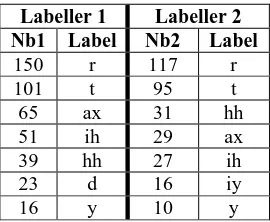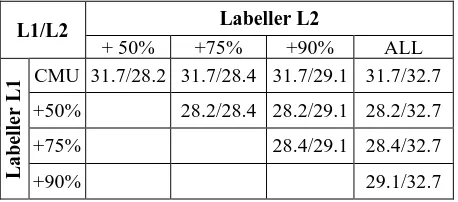CoALT: A Software for Comparing Automatic Labelling Tools
Dominique Fohr, Odile Mella
LORIA-INRIA
Nancy Grand Est
Bâtiment C LORIA, B.P. 239 F54506 Vandoeuvre-lès-Nancy, FranceE-mail: {fohr,mella}@loria.fr
Abstract
Speech-text alignment tools are frequently used in speech technology and research. In this paper, we propose a GPL software CoALT (Comparing Automatic Labelling Tools) for comparing two automatic labellers or two speech-text alignment tools, ranking them and displaying statistics about their differences. The main feature of CoALT is that a user can define its own criteria for evaluating and comparing the speech-text alignment tools since the required quality for labelling depends on the targeted application. Beyond ranking, our tool provides useful statistics for each labeller and above all about their differences and can emphasize the drawbacks and advantages of each labeller. We have applied our software for the French and English languages but it can be used for another language by simply defining the list of the phonetic symbols and optionally a set of phonetic rules. In this paper we present the usage of the software for comparing two automatic labellers on the corpus TIMIT. Moreover, as automatic labelling tools are configurable (number of GMMs, phonetic lexicon, acoustic parameterisation), we then present how CoALT allows to determine the best parameters for our automatic labelling tool.
Keywords: speech-text alignment, automatic labelling, speech processing
1.
Introduction
Speech-text alignment tools are frequently used in speech technology and research: for instance, for training or assessing of speech recognition systems, the extraction of speech units in speech synthesis or in foreign language learning. We propose the software CoALT (Comparing Automatic Labelling Tools) for comparing two automatic labellers or two speech-text alignment tools, ranking them, and displaying statistics about their differences. Our software will be available under GPL.
The main feature of our software is that a user can define its own criteria for evaluating and comparing two speech- text alignment tools. These criteria may vary depending on the application task. For training speech recognition systems, the most important is to find the exact sequence of phonemes, but phoneme boundaries are of little significance due to embedded training. By contrast, in foreign language learning, speech-text alignment must find accurate boundaries in order to compute acoustic or prosodic features for guiding the language learner. In post-synchronisation applications, the critical aim is to find very precise boundaries.
With CoALT, a user can give more importance to either phoneme labels or phoneme boundaries. Indeed, the CoALT elastic comparison algorithm takes into account time boundaries.
Moreover, by providing a set of phonetic rules, a user can define the allowed discrepancies between the automatic labelling result and the hand-labelling one.
Another important feature of CoALT is that it accepts that some hand-labelled boundaries are fuzzy, that is, the human labeller does not have criteria to place the boundary, for instance when /a/ is followed by /R/ in the same French syllable. CoALT doesn’t take into account shifts on fuzzy boundaries.
Beyond ranking, our tool provides useful statistics about each labeller and above all about their differences and can highlight the drawbacks and advantages of each labeller. Of course, CoALT can also be used to compute statistics on only one automatic labeller but it was not designed for that since its aims are comparing and ranking two automatic labellers. The next version will handle any number of automatic labellers.
Another use of CoALT is the tuning of an automatic labeller. Often automatic labelling tools are configurable (number of GMMs, phonetic lexicon, acoustic parameterisation), by comparing them, our software allows to determine the best parameters according to a given task.
We have evaluated our software for the French and English languages but it can be used for another language by simply defining the list of the phonetic symbols and optionally a set of phonetic rules. In this paper we present results for the English language.
The next section describes the CoALT software. We then present an example of its usage for comparing two automatic labellings of the TIMIT test corpus. In section 4, we use CoALT to determine the best parameters of our automatic labelling tool.
2.
CoALT Description
INTERSPEECH 2001. Firenze, pp. 1517--1520.
Kawai, H. and Toda, T. (2004). An Evaluation of Automatic Phone Segmentation for Concatenative Speech Synthesis. In Proceedings of ICASSP 2004, Montreal, pp. 677--680,
Lee, K.-F. And Hon, H.-W. (1989). Speaker-Independent Phone Recognition Using Hidden Markov Models.
IEEE Trans. on Acoustics, Speech, and Signal Processing, v37 n11, pp 1641—1648.
Toledano, D. and Gomez, L. (2003). Automatic Phonetic Segmentation. IEEE Trans. on Speech and Audio
Processing, v11, n6, pp. 617--625.




